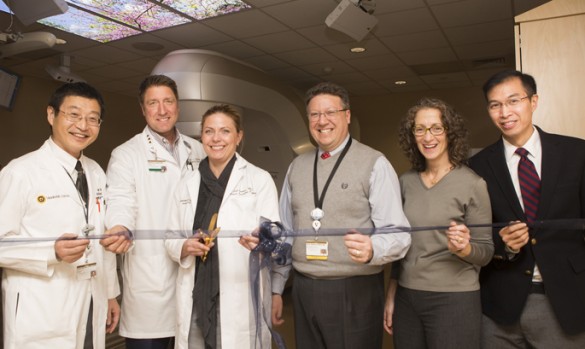
Vanderbilt-Ingram Cancer Center (VICC) has unveiled a new TrueBeam linear accelerator in the Department of Radiation Oncology on the main campus to provide enhanced radiation therapy for patients.
Linear accelerators work by focusing therapeutic doses of radiation to a specific part of the body through a series of lead panels, or ‘leaves,’ that move in and out at pre-set points and angles to help shape the radiation beam.
The TrueBeam system features an improved leaf design that results in less incidental radiation exposure to uninvolved organs and tissues.
Additionally, the device has an enhanced on-board imaging system, which can track patients’ movements during treatment and allows physicians to see the patients’ tumors and normal organs much more clearly.
“Once we have the patient in the right position for treatment, we monitor the patient in real time to make sure they stay in that position,” said Eric Shinohara, M.D., MSCI, associate professor and medical director of Radiation Oncology.
“This real-time imaging also allows our physicians to see the patients’ tumors and normal organs much more clearly. If the tumor shrinks rapidly, we may adapt our remaining treatments to spare more normal tissue.”
Shinohara said the TrueBeam is also 2.5 times faster than older accelerators, making radiation treatments more convenient for patients.
“We want the patient to be much more comfortable and take less time out of their day for treatments.”
Lisa Kachnic, M.D., professor and chair of Radiation Oncology, said the device offers new cutting-edge treatment possibilities and will be unmatched in terms of accuracy for radiation delivery.
“With less than 1 mm accuracy comes two potential great outcomes: first, we may improve the cure rate of the cancer; and second, by minimizing the dose to the normal surrounding tissue, we should see reduced toxicity from the treatments. This technology also has improved capacity to perform stereotactic radiation so that physicians can deliver large radiation doses in many fewer days.”
This is the second TrueBeam system for patient care at VICC. The first is already in use at VICC at Franklin.
Kachnic, who recently came to Vanderbilt from Boston Medical Center where she served as chair of Radiation Oncology and associate director of Multidisciplinary Cancer Research at Boston University School of Medicine, said the new linear accelerator is essential for the kinds of challenging cases that are referred to VICC.
“This novel technology allows us to build upon our department’s strengths, which are the treatment of more complex cases and stereotactic radiosurgery,” Kachnic said. “We perform a lot of retreatments to areas that have received previous radiation, more than I’ve ever seen in my entire career. That’s a large testament to the clinical expertise of our staff, and the TrueBeam will certainly help us to cure such patients without unnecessary toxicity.”
Kachnic said the same experienced faculty members on the main campus also provide care at VICC satellite centers in Franklin, Clarksville and Spring Hill.
“Patients are getting the same quality of treatment at our satellite centers, which I strongly believe is unsurpassed in the region.”












